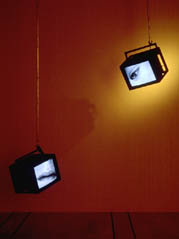
|
| Technical Details: 2-channel
video, black & white; 2-channel audio |
|
In Peter Bogers' work, sound and image are equivalent elements, which always determine form and content in a dynamic interplay. Many of his installations seem to examine the breaking points between sound-music-sound and sound-speech, often with the help of electronics and the human voice. When does sound become music, or vice versa? When do sounds turn into speech, into communication? When does speech falter into inarticulate sound? Bogers also displays an unremitting preoccupation with the human body, which he employs on various levels, not only on video, but also as a spatial element, as conceptual material. In his works, the unity and identity of the body, as it can be perceived from the outside, has made place for fragmentation and alienation.
In Bogers' spatial installations (for example, in Frozen Voice (1992), or Without the Word (1994), the various parts of the body appear, literally and figuratively, to be isolated from each other, and seem to be functioning almost independently from each other, as autonomous parts. Yet there is no explanatory context from outside which determines the meaning: the bodies invariably seem to be engrossed in themselves, to come back to themselves, and the impulses, movements and sounds affecting the disintegrated parts seem to come from within rather than from the outside. It is as if the body, having reached the highest level of self-reflection, obliviously but intimately exposes itself to the viewer, while the sound fills in the intermediate spaces and tries to bridge the gaps.
With Retorica, the intriguing play of image and sound invites you to linger. Two monitors are suspended in the air, one higher than the other, and at an angle to each other. The lowermost monitor alternately shows a close-up of a man's eye or mouth, while the uppermost shows the same facial fragments, but of a baby. The tapes run perfectly synchronously: when you see the man's mouth above, you see the baby's eye below, and vice versa. The images and sounds are aimed at each other: as with a dialogue, one character speaks, while the other listens and watches, observes.
Meanwhile, the images, the man and the baby, together produce the most diverse, primitive, vocal sounds and noises, with no conventional 'word' being uttered. The rhetoric of Retorica: the sounds uttered by the baby are repeated by the man. Meanwhile, they are watching each other closely. There even comes a moment when you are no longer certain who is imitating whom: beginning and end disappear as in a 'loop'.
The sounds are not only unpolished, primitive, rudimentary, raw, and undeveloped, they also comprise the first hint of language and conventional communication. For Retorica, Bogers used video films of himself and his child, and registrations of the sounds his child made during the period just before it actually began to talk. His own seemingly perfect imitation of these sounds is simulated: in fact, only one voice was used, that of the baby, which Bogers changed by means of a voice modulator and then put into his own mouth. The heart-rending interaction between father and child is also the image of a body communicating with itself, which opens up a whole range of latent or long-concealed emotions.
Jorinde Seijdel
|
|
